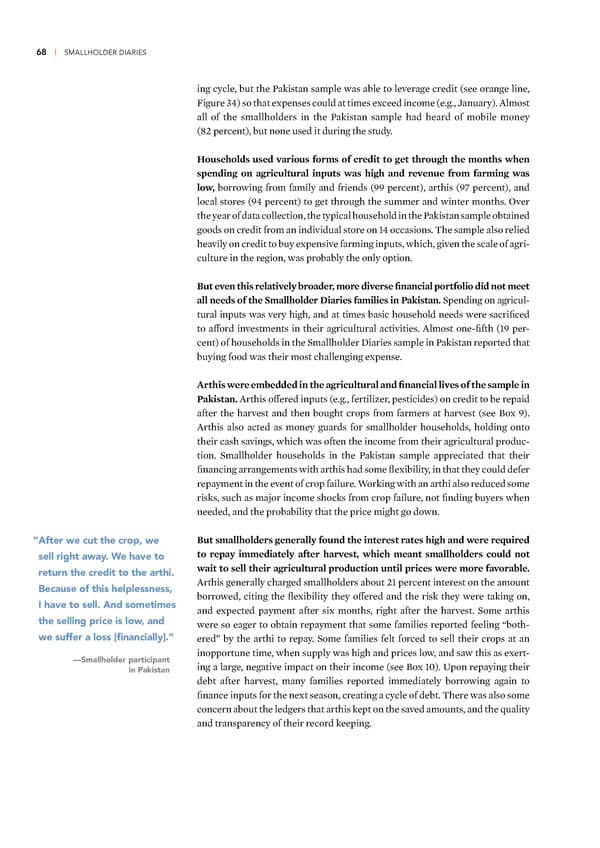68 | SMALLHOLDER DIARIES ing cycle, but the aistan sample was able to leverage credit (see orange line, igure Ÿ“) so that expenses could at times exceed income (eg, Žanuary) ˆlmost all of the smallholders in the aistan sample had heard of mobile money (¡‘ percent), but none used it during the study ›ouseholds used arious forms of credit to get through the months when spending on agricultural inputs was high and reenue from farming was low, borrowing from family and friends (žž percent), arthis (ž• percent), and local stores (ž“ percent) to get through the summer and winter months ¦ver the year of data collection, the typical household in the aistan sample obtained goods on credit from an individual store on …“ occasions Œhe sample also relied heavily on credit to buy expensive farming inputs, which, given the scale of agri- culture in the region, was probably the only option ut een this relatiely broader, more dierse financial portfolio did not meet all needs of the Smallholder Diaries families in ‚aƒistan Spending on agricul- tural inputs was very high, and at times basic household needs were sacrificed to afford investments in their agricultural activities ˆlmost one-fifth (…ž per- cent) of households in the Smallholder ‰iaries sample in aistan reported that buying food was their most challenging expense „rthis were embedded in the agricultural and financial lies of the sample in ‚aƒistan ˆrthis offered inputs (eg, fertili—er, pesticides) on credit to be repaid after the harvest and then bought crops from farmers at harvest (see £ox ž) ˆrthis also acted as money guards for smallholder households, holding onto their cash savings, which was often the income from their agricultural produc- tion Smallholder households in the aistan sample appreciated that their financing arrangements with arthis had some flexibility, in that they could defer repayment in the event of crop failure ™oring with an arthi also reduced some riss, such as ma„or income shocs from crop failure, not finding buyers when needed, and the probability that the price might go down “After we cut the cr op, we ut smallholders generally found the interest rates high and were re uired sell right away. We have to to repay immediately after harest, which meant smallholders could not return the credit to the arthi. wait to sell their agricultural production until prices were more faorable Because of this helplessness, ˆrthis generally charged smallholders about ‘… percent interest on the amount I have to sell. And sometimes borrowed, citing the flexibility they offered and the ris they were taing on, and expected payment after six months, right after the harvest Some arthis the selling price is low, and were so eager to obtain repayment that some families reported feeling “both- we suffer a loss [financially].” ered” by the arthi to repay Some families felt forced to sell their crops at an —Smallholder participant inopportune time, when supply was high and prices low, and saw this as exert- in Pakistan ing a large, negative impact on their income (see £ox …’) ©pon repaying their debt after harvest, many families reported immediately borrowing again to finance inputs for the next season, creating a cycle of debt Œhere was also some concern about the ledgers that arthis ept on the saved amounts, and the uality and transparency of their record eeping
 Financial Diaries with Smallholder Families Page 84 Page 86
Financial Diaries with Smallholder Families Page 84 Page 86